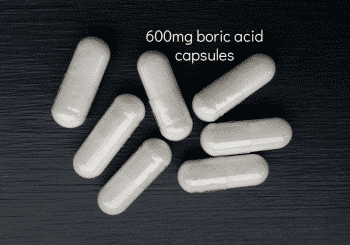Treating a yeast infection with no money
If you can't afford expensive probiotics and tests, there are a couple of very cheap tricks to solving yeast infections.
Dealing with yeast biofilms
Recurrent yeast infections may have their root in a biofilm in your intestine. Learn how to fix it.
Understanding and using povidone-iodine (Betadine) for vaginal infections
Learn about the effectiveness of povidone-iodine (Betadine) vaginally for use in infections such as BV, AV and yeast.
Vitamin D and bacterial vaginosis (BV)
Vitamin D supplementation can help women who have asymptomatic BV, but it has no effect on those with recurrent BV.
How to fill your own 600mg boric acid capsules at home
You can inexpensively fill your own vegetable caps with boric acid at home.
Where can I buy boric acid from?
Woman Seeking Boric Acid.
Antibiotic treatment of men with partners with BV – do they work?
We examine the evidence regarding the effect of antibiotic treatment of male sexual partners of women with BV.
Enterococcus faecalis in the vagina and urinary tract
Enterococcus faecalis is associated with bacterial vaginosis, and should be tested for using PCR testing in unresponsive BV.
Understanding vaginal PCR testing
An explanation of PCR testing for the vaginal microbiome with a list of what is tested for, and what is excluded.
How much powder is 600mg boric acid?
We give examples of what 600mg of boric acid looks like if you don't have it in capsules already, so you can transfer the powder from a jar to a capsule or into another mixture.
How to heat coconut oil and essential oils
We go over the ins and outs of heating coconut oil and essential oils to make your vaginal treatments.
Review: Balance Activ vaginal pessaries and gel
An overview of Balance Activ gel and pessaries, used inthe treatment or management of bacterial vaginosis.
Using probiotics vaginally – you may need to switch capsules
Here we explain how to switch your enteric-coated or gelatin probiotic capsules into vegetable capsules for vaginal use at home.
How to dilute 9, 12 or 35 per cent food-grade hydrogen peroxide to 6 per cent
How to dilute hydrogen peroxide to a 6 per cent mix using a 35 per cent hydrogen peroxide solution, for vaginal use as a douche. Only use as a treatment, not all the time.
Why you get a vaginal yeast infection after antibiotics
How to deal with an antibiotic-driven yeast infection that has taken you by surprise - it's easier than you think to treat, cheaply at home.
Understanding and treating aerobic vaginitis (AV)
Discover the symptoms, causes, and effective treatments for AV, and understand its relationship with other conditions.
Genital warts caused by HPV
Genital warts are almost always caused by a variant of the HPV virus, however it isn't necessarily the same strain that causes cervical cancer. What strain you end up will determine if you could get genital warts or not. Genital warts are easily treated.
Causes of excessive vaginal discharge
We review some causes of excessive vaginal discharge.
Smoking and BV
Smoking affects the vaginal microbiome and urinary tract in several important ways, contiruting directly to BV and UTIs.
Study: tea tree and coconut vinegar for inhibiting biofilm growth and killing G. vaginalis
A small lab study looked at the ability of tea tree oil and coconut vinegar to inhibit the growth of the biofilms of and kill Gardnerella vaginalis.









